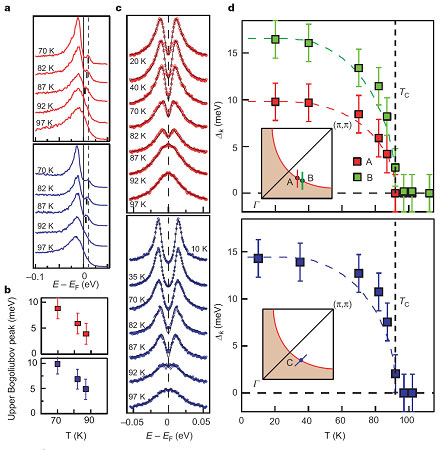Since the discovery of high-temperature superconductor by Bednorz and Müller in 1986, this field has become one of the most important research topics in solid state physics. In the past 20 years many unconventional properties have been discovered in this new class of materials. These have challenged our conventional wisdom and driven the development of many novel theories. Among these discoveries, the most mysterious is probably the pseudogap phenomena: it has been observed that there is an energy gap above the superconducting transition temperature (TC) that persists over a wide range of temperatures and chemical compositions [1]. This peculiar behavior appears to be very different from a conventional superconductor. Here the electrons form so-called "Cooper pairs", which manifests itself as an energy gap in many spectroscopic measurements. This energy gap, known as superconducting gap, appears only below TC where the electrical resistance also vanishes (hence the name 'superconductor'). This important difference has stimulated lots of debate in the search of understanding high-TC superconductivity on questions such as: "What is the pseudogap?" and "What is its relation to superconducting gap and superconductivity at high temperature?"
Early measurements of the energy gap via scanning tunneling spectroscopy (STM) and angle-resolved photoemission spectroscopy (ARPES) near the Brillouin zone boundary (antinodal region) suggested a smooth transition from a pseudogap to a superconducting gap. Hence, the pseudogap state was interpreted as the precursor state of superconducting state but without the phase coherence of the Cooper pairs (a necessary condition for superconductivity). On the other hand, other measurements such as Andreev reflection and time-resolved spectroscopy, observed a superconducting gap that appears at TC as the temperature is lowered, similar to the behavior of the conventional superconductors. In this interpretation, the pseudogap and superconducting gap are two different energy scales representing different ordering phenomena. To resolve this contradiction and gain further insight of pseudogap phenomena, researchers Wei-Sheng Lee and Inna Vishik along with their co-workers in Prof. Zhi-Xun Shen's group at Stanford University, have recently made an important discovery about the temperature dependence of the gap along the Fermi surface. These results provide more crucial evidence of the coexistence of two energy gaps and clarify the relationship between them.
The measurements were performed at SSRL Beam Line 5-4 using the state-of-the-art ARPES system. The excellent beam stability and high data acquisition efficiency allow Lee et al. to measure the gap of underdoped superconducting cuprates, Bi2212, along Fermi surface with ultrahigh resolution (3-5meV) and unprecedented detail in both momentum space and temperature. The surprising results obtained from these measurements allowed them to address the issue of pseudogap and superconducting gap in a way missed by the previous ARPES measurements on the same topic.

The biggest surprise is the temperature dependence of the gap near the diagonal of the Brillouin zone, where the gap is in general small and has been overlooked in the previous measurements. As shown in the symmetrized spectra (Fig. 1(c)), the gap apparently vanishes at the superconducting transition temperature in a BCS-like fashion. This is confirmed by fitting the gap to a phenomenological model (Fig. 1(d)). This behavior is in stark contrast to the gap at the antinodal region, where the gap magnitude remains almost unchanged across Tc and smoothly evolves into pseudogap. Further evidence of such a temperature dependence can also be found in the raw spectra shown in Fig. 1(a). Due to significant thermal population above the Fermi energy (EF) at higher temperatures, the upper branch of the Bogoliubov dispersion, which represents a mixture of electron and hole states and is a hallmark of the superconducting state, can be seen as a small peak above EF (indicated by the short bars in Fig. 1(a)). As the temperature approaches TC, its peak position (Fig. 1(b)) moves closer to EF, suggesting a rapid decrease of the gap. The Bogoliubov dispersion eventually disappears above TC when no gap can be detected at this momentum position, consistent with the conventional BCS superconductor.
As also described in their paper published in Nature, the different temperature dependence at different momentum positions along the Fermi surface leads to a highly nontrivial temperature dependent evolution of the gap function. This may contain important information to further reveal the relationship between the superconducting gap and pseudogap. In any case, together with their previous work on heavily underdoped Bi2212 system published in Science last year [2], it is now well established that the superconducting gap and pseudogap are two distinct energy scales in the single-particle spectrum. This should provide an important step toward unveiling the mystery of the pseudogap phenomena.
- T. Timusk, B. Statt, Rep. Prog. Phys. 62, 61 (1999).
- K. Tanaka et al., Science 314, 1910 (2006).
W. S. Lee, I. M. Vishik, K. Tanaka, D. H. Lu, T. Sasagawa, N. Nagaosa, T. P. Devereaux, Z. Hussain and Z.-X. Shen, Nature 450, 81 (2007)




